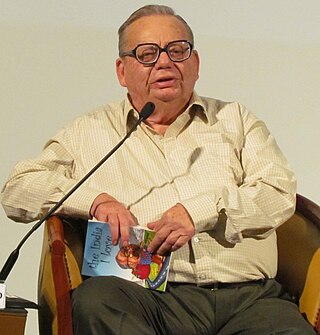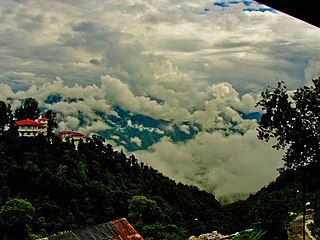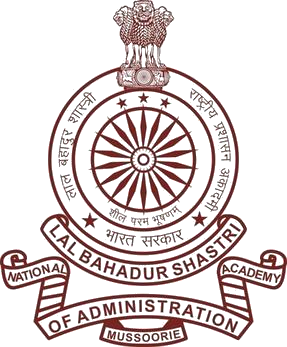
Ruskin Bond is an Indian author. His first novel, The Room on the Roof, was published in 1956, and it received the John Llewellyn Rhys Prize in 1957. Bond has authored more than 500 short stories, essays, and novels which includes 69 books for children. He was awarded the Sahitya Akademi Award in 1992 for Our Trees Still Grow in Dehra. He was awarded the Padma Shri in 1999 and Padma Bhushan in 2014. He lives with his adopted family in Landour, Mussoorie, in the Indian state of Uttarakhand.

Dehradun, also known as Dehra Doon, is the capital and the most populous city of the Indian state of Uttarakhand. It is the administrative headquarters of the eponymous district and is governed by the Dehradun Municipal Corporation, with the Uttarakhand Legislative Assembly holding its winter sessions in the city as its winter capital. Part of the Garhwal region, and housing the headquarters of its Divisional Commissioner. Dehradun is one of the "Counter Magnets" of the National Capital Region (NCR) being developed as an alternative center of growth to help ease the migration and population explosion in the Delhi metropolitan area and to establish a smart city in the Himalayas. It is the third largest city in the Himalayas after Kathmandu and Srinagar.

Mussoorie is a hill station and a municipal board, near Dehradun city in the Dehradun district of the Indian state Uttarakhand. It is about 35 kilometres (22 mi) from the state capital of Dehradun and 290 km (180 mi) north of the national capital of New Delhi. The hill station is in the foothills of the Garhwal Himalayan range. The adjoining town of Landour, which includes a military cantonment, is considered part of "greater Mussoorie", as are the townships Barlowganj and Jharipani.

Landour, a small cantonment town contiguous with Mussoorie, is about 35 km (22 mi) from the city of Dehradun in the northern state of Uttarakhand in India. The twin towns of Mussoorie and Landour, together, are a well-known British Raj-era hill station in northern India. Mussoorie-Landour was widely known as the "Queen of the Hills". The name Landour is drawn from Llanddowror, a village in Carmarthenshire in southwest Wales. During the Raj, it was common to give nostalgic English, Scottish, Welsh or Irish names to one's home, reflecting one's ethnicity. Names drawn from literary works were also common, as from those by Robert Burns, Sir Walter Scott, Thomas Hardy, Robert Louis Stevenson and many others.

St. George's College, Mussoorie, is an all-boys boarding and non-boarding school in Mussoorie, in the state of Uttarakhand, India, affiliated to the Council for the Indian School Certificate Examinations board. The school, an all-boys residential and non-residential institution, spreading over 400 acres (1.6 km2) of land, was founded in 1853 by the Capuchin Fathers and entrusted to the Society of the Brothers of St. Patrick (Ireland) in 1894. It was opened in a cottage known as Manor House; the name by which the campus is still known. The students are known as Manorites.

Munich International School (MIS) is a private coeducational international school located in Starnberg, south of Munich, Germany. MIS teaches students from EC to grade 12. Students travel from an area around Munich to attend the school, with the help of a school bus network that reaches into the area around Munich, even all the way to Garmisch-Partenkirchen. The School is divided into three groups: Junior, Middle, and Senior School.

Woodstock School is an international coeducational residential school located in Landour, a small hill station contiguous with the town of Mussoorie, Uttarakhand, India, in the foothills of the Himalayas.

Lal Bahadur Shastri National Academy of Administration (LBSNAA) is a civil service training institute on public policy and public administration in Musoorie, Uttarakhand in India. The academy's main purpose is to train civil servants of the IAS cadre and also conduct the Foundation Course of Group-A Central Civil Services. After completion of training, the trainee officers of IAS cadre are awarded an MA from IIT, Delhi. It has been functioning under the Ministry of Personnel, Public Grievances and Pensions since 1985.

The A-level is a subject-based qualification conferred as part of the General Certificate of Education, as well as a school leaving qualification offered by the educational bodies in the United Kingdom and the educational authorities of British Crown dependencies to students completing secondary or pre-university education. They were introduced in England and Wales in 1951 to replace the Higher School Certificate. The A-level permits students to have potential access to a chosen university they applied to with UCAS points. They could be accepted into it should they meet the requirements of the university.

Myanmar International School (MIS) is an independent coeducational day school, located in Yangon, Myanmar. It is one of 18 international schools located in Yangon and should not be confused with other similarly named international schools in Myanmar, such as MISY. MIS follows the internationally recognized Cambridge International Schools curriculum with a core of academic subjects and a range of enrichment courses and activities, and with an international teaching staff. The current chief education officer of the school is Mr. Peter McMurray.

Manado Independent School (MIS) is a private institution which provides education from Kindergarten age (K1) to Senior High School. MIS was the first school in the region to be granted an international school license by the National Education Department as a school of international standard. All sections of MIS are accredited by the Badan Akreditasi Sekolah Nasional of Indonesia, with "A" (excellent) classifications.

The Melaka International School (MIS) is an international school in Malacca, Malaysia serving the local and expatriate populations. The school was founded in 1993 and was licensed by the Ministry of Education of Malaysia (MOE).
Unison World School is an all girls' residential school in Dehradun, Uttarakhand, India. The school teaches from grades VI to XII. Unison World School has tied up with Kilgraston School (UK), Rangi Ruru Girls School, and St. Francis' College, UK for International Exchange Programmes. The school offers ICSE, ISC and IGCSE, A/AS Level programmes.It is known for its wide range of co-curricular activities and firm educational structure. School ranks among the top All Girls Residential schools in India.
Education in Uttarakhand is provided by various public and private institutions. Uttarakhand had a long tradition of learning and culture.

The Aryan School is a co-educational independent boarding school in Dehradun, Uttarakhand, India. Founded in 2001 by Sunny Gupta director of Wheezal Labs, "the biggest homoeopathic combinations unit in northern India". The school offers modern education based on the Vedic principal.
Guru Nanak Fifth Centenary school Mussoorie (G.N.F.C.S) is a Sikh, international, English medium school in India, Mussoorie. G.N.F.C.S is a boarding school with two separate campuses for boys and girls. The short name for the boys' school is Vincent-Hill while the girls' school is called Shangri-La. G.N.F.C School is located in Mussoorie hill station in Uttrakhand. Vincent-Hill was officially established on 1969 and Shangri-La was founded on 1977.

Kipling Trail is the old walking route that connects Dehradun with the hill station of Mussoorie in India. It was the only means of reaching Mussoorie before the cart roads, for tongas, or roads for automobiles were constructed. It is named after the English novelist Rudyard Kipling, who is believed to have walked the trail in the 1880s, though there is no definite evidence. The trail fell out of use when cars or buses became the preferred mode of transport, but the route is being revived by nature, colonial history and hiking enthusiasts.














